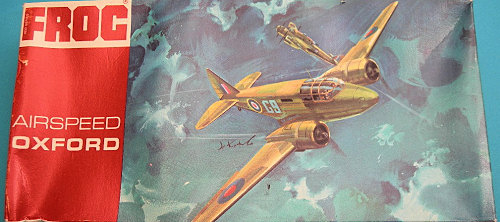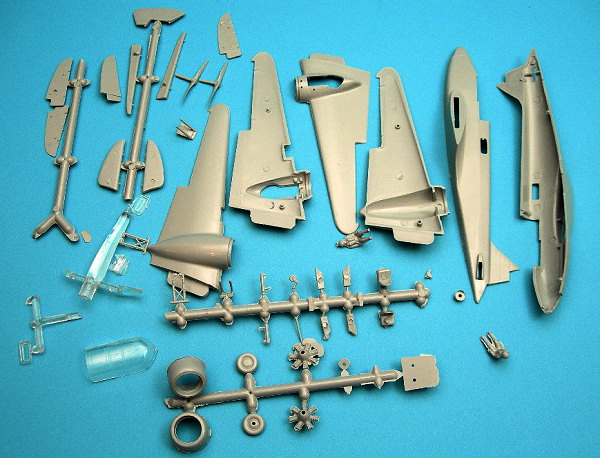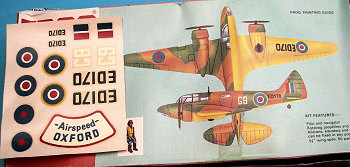
Frog 1/72 Airspeed Oxford
| KIT: | Frog 1/72 Airspeed Oxford |
| KIT #: | F-336 |
| PRICE: | Out of Production |
| DECALS: | One option |
| REVIEWER: | Victor Scheuerman |
| NOTES: | First issued in 1963 |

| HISTORY |
The elegant looking Oxford was largely based on the successful Envoy. Both featured wooden construction and a retractable main landing gear, though different power plants. Airspeed’s Oxford first flew on June 19, 1937 and deliveries started to the RAF in that November. A total of 8,586 Oxfords were built by a variety of manufacturers as Airspeed did not have the production capacity to meet the demand for this trainer.
While five different marks of the Oxford were planned, only three saw operational use. The Mk I was a general-purpose, bombing and gunnery trainer using the Armstrong Cheetah X engine. Thought the Mk II had the same engines, it was used for pilot, radio operator and navigation training. American Pratt & Whitney engines were used on the Mk V and this was used in the same roles as the Mk II.
While the major user was the RAF, it was also widely used by other members of the British Commonwealth Air Training Plan. South Africa was the major user at 700, followed by Australia (400), New Zealand (300), Canada (200), and Rhodesia (10). Other war time users were the Free French and the USAAF. The Oxford was used by the RAF until 1954 and post-war a number were used by the Dutch.
| THE KIT |
 I
must confess this is one of the more poorly done FROG kits in my collection.
While the surface is largely smooth as befits a wooden aircraft (thought the
fuselage roundel location is mark with raised panel lines), the molding quality
is poor. All of the control surfaces are separate and have the raised ribs as
these were all fabric covered. However, there is flash on several parts
(including the clear), and the numerous ejector pin towers will need to be
removed and those clear parts are anything but clear. A total of 50 parts are
included and most will need some cleaning up before construction can begin.
I
must confess this is one of the more poorly done FROG kits in my collection.
While the surface is largely smooth as befits a wooden aircraft (thought the
fuselage roundel location is mark with raised panel lines), the molding quality
is poor. All of the control surfaces are separate and have the raised ribs as
these were all fabric covered. However, there is flash on several parts
(including the clear), and the numerous ejector pin towers will need to be
removed and those clear parts are anything but clear. A total of 50 parts are
included and most will need some cleaning up before construction can begin.
Assembly is covered in five well-drawn steps. Internal detail is modest with the cockpit limited to an abbreviated floor, two seats with separate aircrew. Unfortunately, the kit main landing gear is assembled and attached before the wing halves are joined and I can see this will need to be handled carefully to survive the complete assembly process.
 FROG supplied one decal option
and this appears to be an Mk II as no turret is included and this is painted
with a disruptive camouflage pattern of Dark Earth and Dark Green uppers over
the yellow lower surfaces. This aircraft is serial number ED170 and the large
unit fuselage marking is G9. One of the positive things about the FROG kits was
the scheme(s) are illustrated in full colour on the back of the box (this boxing
even has the aircrew in full colour) and the kit decals still look useable in a
pinch.
FROG supplied one decal option
and this appears to be an Mk II as no turret is included and this is painted
with a disruptive camouflage pattern of Dark Earth and Dark Green uppers over
the yellow lower surfaces. This aircraft is serial number ED170 and the large
unit fuselage marking is G9. One of the positive things about the FROG kits was
the scheme(s) are illustrated in full colour on the back of the box (this boxing
even has the aircrew in full colour) and the kit decals still look useable in a
pinch.
| CONCLUSIONS |
I must say that this kit is a bit of a disappointment, and it will require some extra effort to get it to an acceptable level.
| REFERENCES |
The Encyclopedia of World Aircraft, David Donald, PROSPERO BOOKS
November 2007
If you would like your product reviewed fairly and quickly, please contact me or see other details in the Note to Contributors.